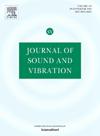A type-3 fuzzy vibration controller based on active rotary inertia driver systems
IF 4.3
2区 工程技术
Q1 ACOUSTICS
引用次数: 0
Abstract
Active rotary inertia driver (ARID) plays a vital role in controlling the rotational inertia of a system, and various ranges of industrial applications like robotics, offshore wind turbines, aerospace, and automotive industries. By actively tuning the rotational inertia, the driver can improve stability, dynamic response, and energy efficiency. Also, the robustness can be improved by adjusting the rotational inertia in real time to counteract natural external disturbances or changes in operating conditions. However, the ARID control problem can be complex due to various factors, including the need for online adjustments, nonlinear dynamics of the system, uncertainties in the operating conditions, and interactions with other components in the system. In this paper, a nonlinear controller based on type-3 (T3) fuzzy logic systems (FLSs) is developed. The suggested controller identifies the closed-loop dynamics automatically and does not depend on the ARID predefined physical/mathematical equations. A T3-FLS is used to estimate the control input nonlinearities, and another T3-FLS is used to estimate the dynamic nonlinearities. The both T3-FLSs are online tuned by the Lyapunov adaptation rules. Also, the impact of other disturbances and estimation errors of T3-FLSs are analyzed, and a parallel controller as a compensator is designed to guarantee stability. The designed controller is examined by an experimental study and various simulations. The results of energy and time–frequency analysis, show that the proposed method has a better control effect on the vibration control. In addition, the proposed method also improves the stability and robustness in the actual conditions (see the implementation video at https://youtube.com/shorts/kR_97RuHotM?si=qN2EyUEW20Xu2CKy).
基于主动旋转惯量驱动系统的3型模糊振动控制器
主动旋转惯性驱动器(ARID)在控制系统的转动惯量以及机器人、海上风力涡轮机、航空航天和汽车工业等各种工业应用中起着至关重要的作用。通过主动调整转动惯量,驾驶员可以提高稳定性、动态响应和能源效率。此外,可以通过实时调整旋转惯量来抵消自然外部干扰或操作条件的变化,从而提高鲁棒性。然而,由于各种因素,包括在线调整的需要、系统的非线性动力学、运行条件的不确定性以及与系统中其他组件的相互作用,ARID控制问题可能会很复杂。本文提出了一种基于3型(T3)模糊逻辑系统的非线性控制器。该控制器可以自动识别闭环动力学,不依赖于ARID预定义的物理/数学方程。用一个T3-FLS估计控制输入非线性,另一个T3-FLS估计动态非线性。两种t3 - fls均采用Lyapunov自适应规则在线调谐。分析了其他干扰和估计误差对t3 - fls系统的影响,设计了并联控制器作为补偿器,保证了系统的稳定性。通过实验研究和各种仿真验证了所设计的控制器。能量分析和时频分析结果表明,该方法对振动控制具有较好的控制效果。此外,所提出的方法还提高了实际条件下的稳定性和鲁棒性(参见https://youtube.com/shorts/kR_97RuHotM?si=qN2EyUEW20Xu2CKy的实现视频)。
本文章由计算机程序翻译,如有差异,请以英文原文为准。
求助全文
约1分钟内获得全文
求助全文
来源期刊

Journal of Sound and Vibration
工程技术-工程:机械
CiteScore
9.10
自引率
10.60%
发文量
551
审稿时长
69 days
期刊介绍:
The Journal of Sound and Vibration (JSV) is an independent journal devoted to the prompt publication of original papers, both theoretical and experimental, that provide new information on any aspect of sound or vibration. There is an emphasis on fundamental work that has potential for practical application.
JSV was founded and operates on the premise that the subject of sound and vibration requires a journal that publishes papers of a high technical standard across the various subdisciplines, thus facilitating awareness of techniques and discoveries in one area that may be applicable in others.
 求助内容:
求助内容: 应助结果提醒方式:
应助结果提醒方式:


